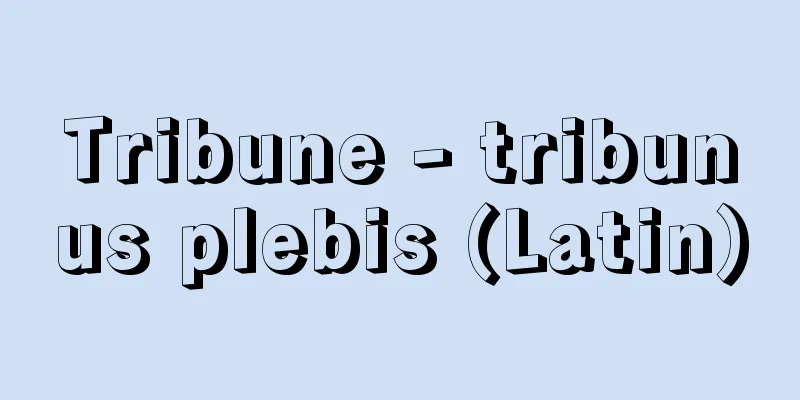Tribune - tribunus plebis (Latin)

|
The leader of the plebeians in ancient Rome, later becoming the title of an official position. In the early 5th century BC, the leader of the plebeians (plebs) in the status struggle with the patricians was allowed to continue as a tribune by the entire state even after the conflict between the two parties ended. In the 5th century BC, the number of tribunes increased to 10, and they were elected by the Plebeian Assembly. Their role was to protect the lives and property of the plebeians, and to that end, they were allowed to veto all actions of the magistrates, elections, laws made by the Assembly, and resolutions of the Senate, etc., and to protect against such obstruction, the entire plebeians protected the sanctity of the tribunes based on a sacred oath. The tribunes also convened and presided over the Plebeian Assembly. In 287 BC, when the resolutions of the Plebeian Assembly came to have the same effect as the decisions (laws) of the Assembly, the tribunes were first allowed to observe the senate meetings, and then became one of the magistrates, and tribunes were allowed to become senators. Thus, what was once a revolutionary force against the state was now institutionalized. The reform movement of the Gracchi brothers revived this revolutionary color, but the Senate countered with the Final Senate Resolution. However, the strength of the tribune's power, which allowed them to veto any state action, was not forgotten, and since Augustus, the tribune's power has been used as the most important pillar of imperial power. At the same time, the tribune itself continued to exist, being a step in the career of a senator, but its duties were completely abolished. Nevertheless, there are traces of the existence of tribunes even in the 5th century. [Yuge Tatsuya] Source: Shogakukan Encyclopedia Nipponica About Encyclopedia Nipponica Information | Legend |
|
古代ローマの平民の指導者、のちに官職名となる。紀元前5世紀初め貴族との身分闘争で平民(プレブス)の指導者であったものが、両者の争いが終わっても国家全体によってその存続を許された。前5世紀にその数は10人となり、平民会で選挙された。その役割は平民の生命・財産を守ることにあり、そのために政務官の行うすべての行動、選挙、民会でつくられた法律、元老院議決、などに対する拒否権を使うことを許され、その妨害行為を守るために平民全体は神聖な誓約に基づいて護民官の神聖不可侵を擁護した。護民官はまた平民会を招集し、主宰した。前287年平民会決議が民会の決定(法律)と同じ効力をもつようになると、護民官は初め元老院会議の傍聴を許され、やがて政務官の一つとなって、護民官就任者は元老院議員となることを許された。こうして、かつては国家に対する革命的勢力であったものが、いまや体制化された。この革命的色彩を復活させたのがグラックス兄弟の改革運動であったが、元老院は最終元老院議決をもってこれに対抗した。しかし、あらゆる国事行為を拒否できた護民官職権の強さは忘れられることなく、アウグストゥス以来、護民官職権は皇帝権力のもっとも重要な柱として使われた。これと並行して護民官そのものも存続し、元老院議員の経歴のなかの一階梯(かいてい)であったが、職務内容はまったくなくなった。それでも5世紀になっても、護民官が存在した痕跡(こんせき)がある。 [弓削 達] 出典 小学館 日本大百科全書(ニッポニカ)日本大百科全書(ニッポニカ)について 情報 | 凡例 |
Recommend
Sozaemon Oshima
...A mining metallurgist of the late Edo and Meij...
Bordeu (English spelling) Théophile de Bordeu
1722‐76 French physician. Born in Iseste to a phys...
Otowa Tanshichi - Otowa Tanshichi
A title for Kabuki and Joruri. Original title Kant...
Kaseda Manor
A manor in Ito District, Kii Province (present-day...
Odan Tapley - Odan Tapley
…It was during this period that Mahayana Buddhism...
Pea - Pisum sativum; pea
An annual or biennial plant of the legume family. ...
Infighting - Infighting
...A sport in which opponents wearing gloves on b...
Georgius
A young Roman officer and saint. Around 303, he w...
"Kaiyahentai" - Kaihentai
...Information from overseas brought by Qing merc...
Wife - Wife
… [Japanese Shamanism] Japanese shamanism has bee...
Acrodextrin - Acrodextrin
…These are collectively called dextrins. Among th...
Appen, K.von (English spelling) AppenKvon
…His work with the Berliner Ensemble won worldwid...
Phoenicopteridae
…any bird of the family Phoenicopteridae, order C...
Vilenkin, NM
…Russian poet. His real name was NM Vilenkin. He ...
Voter - Voter
〘 noun 〙① A person who has rights. ② Especially, a...









